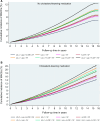Low-density lipoprotein cholesterol, lipoprotein(a) and high-sensitivity C-reactive protein are independent predictors of cardiovascular events
- PMID: 40320753
- PMCID: PMC12517743
- DOI: 10.1093/eurheartj/ehaf281
Low-density lipoprotein cholesterol, lipoprotein(a) and high-sensitivity C-reactive protein are independent predictors of cardiovascular events
Erratum in
-
Correction to: Low-density lipoprotein cholesterol, lipoprotein(a) and high-sensitivity C-reactive protein are independent predictors of cardiovascular events.Eur Heart J. 2025 Jun 12:ehaf416. doi: 10.1093/eurheartj/ehaf416. Online ahead of print. Eur Heart J. 2025. PMID: 40504690 No abstract available.
Abstract
Background and aims: Associations of hyperlipidaemia and inflammation with the risk for incident major adverse cardiovascular events (MACEs) were analysed in individuals with and without cholesterol-lowering medication therapy.
Methods: Data from 322,922 participants (55.9% women) aged 38 to 73 years from the UK Biobank were included. Longitudinal associations of low-density lipoprotein cholesterol (LDL-C), lipoprotein(a) [Lp(a)], and high-sensitivity C-reactive protein (Hs-CRP), both individually and in combination, were analysed with the risk for incident MACEs using Cox regression models, stratified by cholesterol-lowering medication use.
Results: During a median follow-up of 13.7 years, 31,295 (9.69%) participants had incident MACEs. The incidence was 8.32% in non-users and 18.6% in users of cholesterol-lowering medication. Higher LDL-C levels were associated with the highest risk for MACEs, followed by Lp(a) and Hs-CRP. One higher standard deviation in LDL-C, Lp(a), and Hs-CRP was associated with a 13%, 8%, and 6% greater risk for MACEs in non-users and 11%, 7%, and 6% in cholesterol-lowering medication users, respectively. When combined, LDL-C, Lp(a), and Hs-CRP demonstrated a synergistic effect. Compared with individuals with all three biomarkers at or below the 75th percentile, those with all three biomarkers above the 75th percentile had a 77% higher risk for incident MACEs among non-users and a 58% higher risk among those on cholesterol-lowering medications.
Conclusions: Hyperlipidaemia and inflammation independently and synergistically contribute to an increased risk for incident cardiovascular events. The magnitude of risk is more closely related to serum biomarker concentrations than to the use or not of cholesterol-lowering medications.
Keywords: Cardiovascular mortality; Cholesterol-lowering medication; High-sensitivity C-reactive protein; Hyperlipidemia; Lipoprotein(a); Low-density lipoprotein cholesterol; Residual risk.
© The Author(s) 2025. Published by Oxford University Press on behalf of the European Society of Cardiology.
Figures




References
-
- Willeit P, Ridker PM, Nestel PJ, Simes J, Tonkin AM, Pedersen TR, et al. Baseline and on-statin treatment lipoprotein(a) levels for prediction of cardiovascular events: individual patient-data meta-analysis of statin outcome trials. Lancet 2018;392:1311–20. 10.1016/S0140-6736(18)31652-0 - DOI - PubMed
-
- Puri R, Nissen SE, Arsenault BJ, St John J, Riesmeyer JS, Ruotolo G, et al. Effect of C-reactive protein on lipoprotein(a)-associated cardiovascular risk in optimally treated patients with high-risk vascular disease: a prespecified secondary analysis of the ACCELERATE trial. JAMA Cardiol 2020;5:1136–43. 10.1001/jamacardio.2020.2413 - DOI - PMC - PubMed
MeSH terms
Substances
Grants and funding
LinkOut - more resources
Full Text Sources
Medical
Research Materials
Miscellaneous

